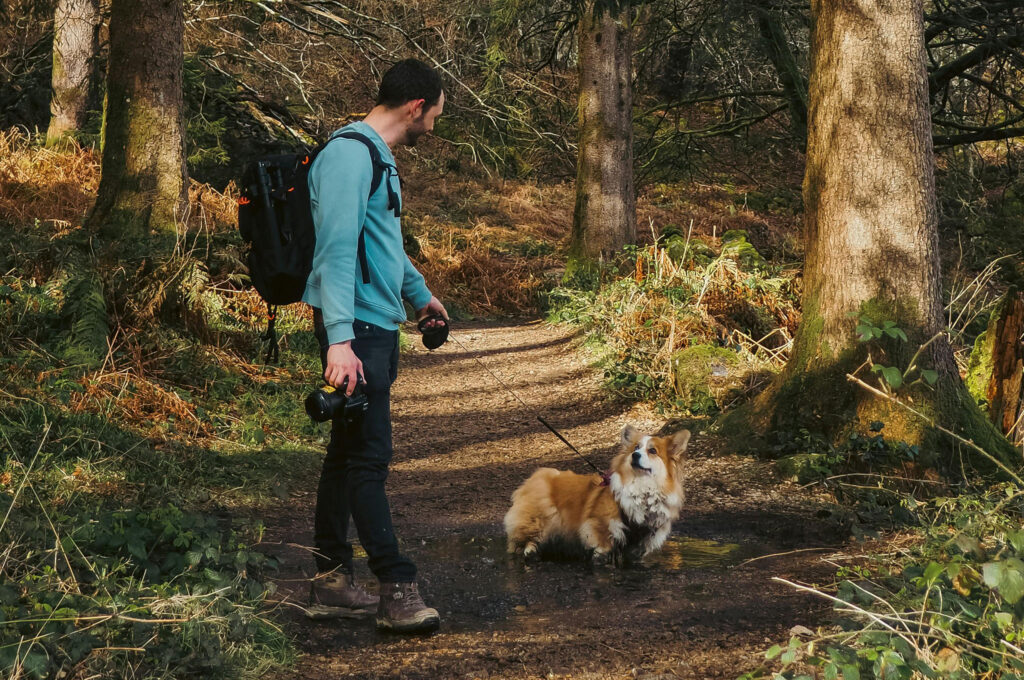
One of the best things about a vacation with your dog is the quality time and activities you get to do together. Hiking provides an excellent opportunity for dog owners to bond with their pets in the great outdoors. A Forbes survey revealed that 82% of dog owners sometimes travel with their dogs by car. As more people seek outdoor activities that involve their furry companions, hiking has become increasingly popular among dog owners, particularly while on a road trip.
Hiking provides dogs a great workout, helping them burn off excess energy and maintain a healthy weight. Nature’s sights, sounds, and smells provide dogs with valuable mental stimulation, which can prevent boredom.
However, there are some things you must prepare for and check before hiking off into the sunset with your pooch.
Things to do before hiking with your dog
Before embarking on a hike with your dog, it’s essential to check weather forecasts and trail conditions for the area you’ll be exploring. This information helps you prepare adequately and ensures a safer and more enjoyable experience for you and your furry companion.
Pay attention to factors such as temperature, precipitation, wind, and potential hazards like storms or extreme heat. Adjust your plans accordingly based on the forecasted conditions.
Additionally, research recent trail reports or updates to learn about any trail closures, maintenance work, or other factors that may affect your hike.
Research the area you’re planning to hike. Understanding leash laws and trail regulations ensures that you comply with local laws and regulations governing dog ownership and outdoor recreation. This helps avoid potential fines or penalties for violating leash laws or other regulations.
Proper preparation, including assessing the trail’s difficulty and terrain, ensures your and your dog’s safety during the hike. Considering your dog’s physical condition and limitations is crucial for their well-being on the trail. Gradually build endurance and stamina, choose appropriate trails, and help adequate rest breaks prevent overexertion and injury.
Things to pack before a dog-friendly hike
- Food and water: Ensuring your dog stays hydrated and well-fed during the hike is essential for their health and energy levels. Bringing plenty of water and portable food options and monitoring your dog’s intake helps prevent dehydration and exhaustion—don’t forget water for yourself, too!
- A quality leash: A sturdy leash provides you with control over your dog’s movements, especially in potentially hazardous situations such as encountering wildlife, steep terrain, or busy trails. This control helps prevent your dog from wandering off-trail, getting into dangerous situations, or approaching other hikers or animals without your supervision.
- Waste bags: Mindfulness of the environment and wildlife is important for minimizing one’s impact on natural habitats and ecosystems. This includes following Leave No Trace principles, respecting wildlife, and properly disposing of waste.
- First aid kit: It’s essential to have a dog-specific first aid kit with items such as antiseptic solution and gauze. However, knowing when to seek veterinary care is essential to ensure prompt treatment and the best possible outcome for your dog’s health and well-being.
- Weather-appropriate clothing: Dressing appropriately for the weather is essential for you and your dog to stay comfortable and protected during the hike. Consider dressing your dog in a coat or sweater in colder weather to provide extra warmth. In hot weather, avoid hiking during the hottest part of the day and opt for early morning or evening hikes instead.
Things to remember while on your hike
- Many trails and outdoor recreational areas have designated leash-required areas or seasonal leash restrictions to protect sensitive habitats and wildlife. Respecting these regulations helps preserve natural ecosystems and prevent disturbance to wildlife nesting or foraging areas.
- Stick to designated trails and avoid venturing off-trail, which can disrupt wildlife habitats and cause soil erosion. Additionally, staying on marked trails helps protect fragile ecosystems and prevents the spread of invasive species.
- Respect other hikers’ rights to enjoy the trail without interference or disturbance from your dog. Keep your dog under control, yield to oncoming hikers, and step aside to allow others to pass safely. Always ask permission before allowing your dog to interact with other hikers or their pets.
- You must also take extra care during hunting season. Knowing when hunting activities are permitted helps you plan your hike accordingly and avoid areas where hunting may occur. This reduces the risk of accidental encounters with hunters and potential dangers to you and your dog.
- Be aware of any toxic plants in the area. Many hiking trails are surrounded by diverse vegetation, some of which may include toxic plants that can harm dogs if ingested. Familiarizing yourself with common toxic plants in your hiking area is crucial. If you suspect your dog has ingested a toxic plant or is exhibiting symptoms of plant poisoning, seek veterinary care immediately for proper diagnosis and treatment. However, if you stick to designated trails, you can help protect your furry companion from the risks of plant poisoning while enjoying outdoor adventures together.
Exploring the great outdoors with your furry companion is a great way to spend a vacation. Our spacious rental cars provide ample storage space to pack all the essentials you need for an enjoyable hiking experience for both your dogs and you.